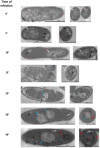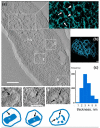Maturation of Pseudo-Nucleus Compartment in P. aeruginosa, Infected with Giant phiKZ Phage
- PMID: 33096802
- PMCID: PMC7589130
- DOI: 10.3390/v12101197
Maturation of Pseudo-Nucleus Compartment in P. aeruginosa, Infected with Giant phiKZ Phage
Abstract
The giant phiKZ phage infection induces the appearance of a pseudo-nucleus inside the bacterial cytoplasm. Here, we used RT-PCR, fluorescent in situ hybridization (FISH), electron tomography, and analytical electron microscopy to study the morphology of this unique nucleus-like shell and to demonstrate the distribution of phiKZ and bacterial DNA in infected Pseudomonas aeruginosa cells. The maturation of the pseudo-nucleus was traced in short intervals for 40 min after infection and revealed the continuous spatial separation of the phage and host DNA. Immediately after ejection, phage DNA was located inside the newly-identified round compartments; at a later infection stage, it was replicated inside the pseudo-nucleus; in the mature pseudo-nucleus, a saturated internal network of filaments was observed. This network consisted of DNA bundles in complex with DNA-binding proteins. On the other hand, the bacterial nucleoid underwent significant rearrangements during phage infection, yet the host DNA did not completely degrade until at least 40 min after phage application. Energy dispersive x-ray spectroscopy (EDX) analysis revealed that, during the infection, the sulfur content in the bacterial cytoplasm increased, which suggests an increase of methionine-rich DNA-binding protein synthesis, whose role is to protect the bacterial DNA from stress caused by infection.
Keywords: Pseudomonas aeruginosa; analytical electron microscopy; electron tomography; fluorescent in situ hybridization; giant phage; nucleoid; phiKZ; pseudo-nucleus; stress response.
Conflict of interest statement
The authors declare no conflict of interest.
Figures






References
-
- Ceyssens P.-J., Minakhin L., Van den Bossche A., Yakunina M., Klimuk E., Blasdel B., De Smet J., Noben J.-P., Blasi U., Severinov K., et al. Development of giant bacteriophage ϕKZ is independent of the host transcription apparatus. J. Virol. 2014;88:10501–10510. doi: 10.1128/JVI.01347-14. - DOI - PMC - PubMed
-
- Lecoutere E., Ceyssens P.-J., Miroshnikov K.A., Mesyanzhinov V.V., Krylov V.N., Noben J.-P., Robben J., Hertveldt K., Volckaert G., Lavigne R. Identification and comparative analysis of the structural proteomes of ϕKZ and EL, two giant Pseudomonas aeruginosa bacteriophages. Proteomics. 2009;9:3215–3219. doi: 10.1002/pmic.200800727. - DOI - PubMed
Publication types
MeSH terms
Substances
LinkOut - more resources
Full Text Sources

